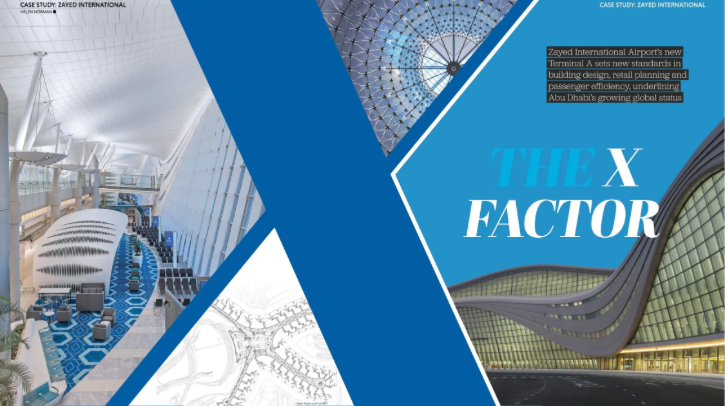Zayed International Airport’s new Terminal A sets new standards in building design, retail planning and passenger efficiency, underlining Abu Dhabi’s growing global status.
Rebranding
Abu Dhabi International Airport was renamed Zayed International Airport in February 2024, on the instruction of United Arab Emirates (UAE) President His Highness Sheikh Mohamed Bin Zayed Al Nahyan.
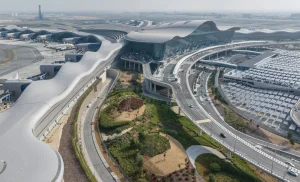
The renaming was intended to honor the UAE’s founding father, the late Sheikh Zayed bin Sultan Al Nahyan. His Excellency Sheikh Mohammed bin Hamad bin Tahnoon Al Nahyan, special affairs advisor at the Presidential Court and chairman of Abu Dhabi Airports’ board of directors, attended the renaming ceremony, where he said, “We are immensely proud to rename Abu Dhabi’s largest airport in honor of the founding father of the UAE. The unsurpassed achievements of the late Sheikh Zayed in connecting our country to nations around the world have inspired our commitment to ensuring that Abu Dhabi further strengthens its position as a world-leading hub for travel, trade and commerce.
“I would like to thank His Highness Sheikh Mohamed bin Zayed for entrusting us with carrying forward the name of the Founding Father, helping to commemorate his unforgettable legacy that impacts us to this day, and will continue to inspire future generations. Opening its gates to the world, Zayed International Airport ushers in a new era for Abu Dhabi’s aviation sector. The airport’s state-of-the-art infrastructure delivers exceptional connectivity, innovation and sustainability for an elevated guest experience while propelling regional tourism, trade and commerce to new heights.”
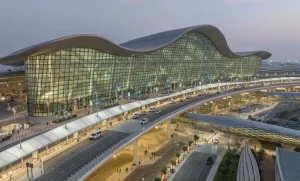
The renaming is part of the airport’s aim to celebrate the emirate of Abu Dhabi. To support this goal, the airport also unveiled a new brand identity inspired by its landscape and history, as well as by the design of the airport itself. A traditional dhow boat, a date palm tree, the desert sun, the Qasr Al Hosn fort and Terminal A served as creative sources for the new logo. The launch of Zayed International Airport’s new brand was accompanied by video highlights of more than 1,750 drones coming together in an air display to form the airport’s new logo.
The United Arab Emirates’ newest airport terminal – the US$3bn Terminal A at Zayed International Airport (formerly known as Abu Dhabi International Airport) – made quite an entrance into the airport world in 2023. The much-delayed new hub, which officially opened its doors in November, was thrust into the spotlight earlier in 2023 when it featured in one of the highest-grossing movies of the year, Mission: Impossible – Dead Reckoning Part One. What’s more, in September the terminal was the arrival point for UAE astronaut Sultan Al Neyadi after his six-month mission aboard the International Space Station.
Both ‘missions’ put the new terminal, which is one of the largest in the world, under a global spotlight ahead of its official opening and showcased the facility’s impressive design – an X-shaped building constructed to maximize efficiency for passengers navigating the space.
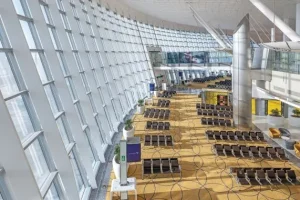
But it hasn’t been all plain sailing. Terminal A – previously referred to as the Midfield Terminal – has been a long time coming. Construction began back in 2012, with an original completion date of 2017. The project was delayed due to funding disputes and challenges associated with the Covid-19 pandemic.
However, on November 1, 2023, after more than a decade in the works, Terminal A began operations, with flights from Zayed International’s existing terminals 1, 2 and 3 transitioning to the new facility over a two-week period.
Covering 742,000m2 of built-up area, Terminal A has significantly increased Zayed International’s passenger and cargo capacity. It can accommodate up to 45 million passengers per year, which is almost three times more than the previous capacity of 15.5 million passengers in 2022. The terminal can also process up to 11,000 travelers per hour and operate 79 aircraft at any given time.
Future growth
The new Terminal A will help Zayed International cope with increasing passenger numbers, according to Elena Sorlini, the managing director and CEO of airport operator Abu Dhabi Airports.
“Abu Dhabi is increasingly becoming a desirable base for airlines and a destination for visitors,” she explains. “In 2023 Zayed International Airport’s traffic increased year-on-year by more than 40% to 22.5 million passengers and in January 2024 we have experienced a further growth of 34% versus last year, a development that is way above the international trend.
“In January 2024 the airport also connected travelers to 124 destinations worldwide, becoming a vital regional hub and supporting the positive development in the tourist sector, with Abu Dhabi Department of Culture and Tourism setting 2023 targets to increase overall visitation to more than 24 million from 18 million in 2022. The new terminal was needed to meet this growth in demand and unlock the full potential of Abu Dhabi tourism and trade,” she adds.
Sorlini and her team now plan to attract more airlines to Terminal A. To cater to the increased passenger numbers this will bring, she says that the facility has been futureproofed: “The masterplan of Terminal A has been designed so that we can expand capacity in a modular way when needed. The plan foresees the additions of concourses in front of the main terminal connected with an airport people mover, taking current capacity from 45 million to 65 million passengers in phases, when required.”
It is expected that capacity will be increased to 65 million over the next 10 years. This growth in passenger numbers is also in line with home carrier Etihad Airways’ plans to double its fleet to 150 airplanes by 2030.

One-roof building
According to Mustafa Chehabeddine, design principal at Kohn Pedersen Fox (KPF), the lead architect for Terminal A, the new facility has been designed with “unprecedented flexibility” to allow for this future growth and for changes in passenger demands. He explains, “This flexibility has been created by replacing columns with ‘mega-arches’, allowing for future changes within the space. Connection to future satellite terminals is also provided in the current design.”
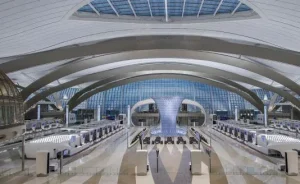
The arches Chehabeddine refers to were not without their challenges. “Terminal A’s one-roof building is supported by 18 long-spanning, leaning arches,” he says. “Constructing the mega-arches, which at their widest point span 180m, pushed the boundaries of construction and required a true collaboration between lead architect KPF and structural engineer Arup. The terminal has set a new standard to create a truly awe-inspiring space and interiors that are urban in scale.”
The X-shaped design of the new terminal also set new standards when it came to modeling. “The X-shaped plan was developed using parametric geometry modeling to achieve the best layout for passenger flow,” Chehabeddine explains. “This is a major airport for international connections with a large percentage of transferring passengers. The building form helped create a civic center at the heart of the terminal. Meanwhile, the centralized baggage handling system [capable of processing up to 19,200 bags per hour] has reduced transfer times to as little as 45 minutes, which is best in class.”
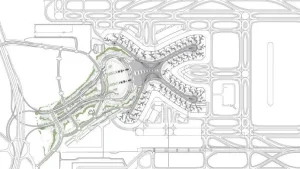
According to Sorlini, the X-shaped design of the terminal, which also has a centralized security checkpoint, offers a “smoother experience” for passengers. “Working alongside the architects, we specifically focused on creating a terminal where travel is as efficient as possible to eliminate those frustrating long lines and delays in areas like passport control and security,” she explains.
“We now have a world-leading, state-of-the-art terminal where passengers can go from the curb to the gate in an average of 14 minutes. The maximum would be around 17 minutes. The feedback from the passengers so far has been extremely positive,” she adds.
Technology and sustainability
Further enhancing efficiency for passengers, Terminal A will be the first in the world to include all nine biometric airport touchpoints (pre-travel enrolment, check-in desk, self-service bag drop, biometric e-gate, immigration counter, retail, lounge, boarding gate, transit) once fully operational. In the first phase, biometric solutions have been installed in key areas, such as self-service bag drops, immigration e-gates and boarding gates. When fully operational, the terminal will use facial recognition technology to screen passengers and minimize wait times.
“We are also planning to deploy biometric solutions in our retail units to make the overall shopping experience easier,” explains Sorlini. “The technology will allow passengers to access airport services without additional identification while providing a more personalized, quick and convenient travel experience, enhancing safety and security.”
Sustainability was also a key focus for the team behind Terminal A, and there have been extensive environmental initiatives both inside and outside. The facility is ‘green building certified’ under the Pearl Building Rating System (PBRS), which promotes the development of buildings that are sustainable and improve the quality of life.
“Passengers can go from the curb to the gate in an average of 14 minutes”
– Elena Sorlini, Abu Dhabi Airports
“More than 90% of the steel used in the construction is recycled, and 82% of the timber is certified from sustainable sources,” Sorlini explains. “Meanwhile, water-efficient fixtures and fittings have been installed throughout, resulting in a reduction in water consumption of 45%.
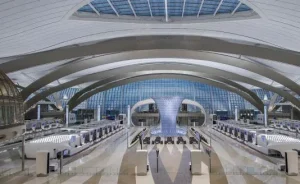
“The parking garage outside has 7,500 solar panels that power a 3MW plant, saving 5,300 tons of carbon dioxide annually, which equates to emissions from 1,060 vehicles for 12 months. More than 70% of the plants used in Terminal A’s campus landscaping are native and adaptive species that are drought- and saline-resistant,” she adds.
The use of glass also reduced reliance on internal lighting: “A key challenge here, however, was to create daylit spaces while protecting passengers against glare and overheating, without the use of external shading devices, which could be affected by sand accumulation,” says Chehabeddine. “The undulating form of the roof, which drapes over the façade, reduced the amount of glazing along the piers by 50%. The façade was also inclined to reduce the impact of the desert sun. High-performance glass, with fritting in a graduated pattern, was used to further control glare.”
Retail design
Terminal A also features an array of world-class amenities, including luxurious lounges, relaxation zones and spa facilities where passengers can rest and rejuvenate. “The new terminal consists of a significant 35,000m2 allocated to retail space, with 163 outlets for passengers to shop and eat at,” Sorlini explains. “This will be increased to 175 outlets by the end of 2024 and to 187 by 2025. It will also feature two health and beauty spas, a 138-room hotel and an open-air lounge. Meanwhile, new flagship lounges – spread across three floors – offer dining options, a rooftop cocktail bar, relaxation spaces, a games room and a family room.”
London-based retail architecture and design practice The Design Solution (TDS) was tasked with commercial planning for the new Terminal A, working alongside Aer Rianta International (ARI) and local partners, operating as Travel Retail Sales and Services (TRSS). Robbie Gill, managing director of TDS, says, “The vast scale of the terminal was challenging, particularly with the central space able to fit a football pitch between the columns. The solution was to create ‘lily pads’ of commercial pods to entice passengers to explore across this vast space.
“Alongside the pods, the retail space includes the main duty-free store, four soaring icon stores and four category-focused arcades,” he continues. “The retail adventure is absolutely integral to the travelers’ experience of the whole terminal, setting a remarkable new benchmark for the industry.”
Sustainable F&B
Within the F&B offering, SSP Emirates Abu Dhabi opened a new Food Park at Terminal A, featuring an array of internationally renowned brands and local concepts, selected to appeal to the unique passenger profile of the airport. “The Food Park offers everything from grab-and-go to sit-down dining, and because we were able to design it from scratch, it offers the optimum passenger flow,” says Mark Angela, chief business development and strategy officer at SSP.
Just as within the wider terminal space, sustainability has been a key priority in the development of the SSP Food Park. “For example, 90% of the wood used in the build of the SSP units came from recycled or reclaimed sources, and 85% of all floor and wall tiling used is locally sourced with a minimum of 20% recycled content,” explains Angela. “In addition, the units have been fitted with water-based air-conditioning and a system to extract steam from hoods and recycle it into clean air, alongside other energy-efficient equipment.”
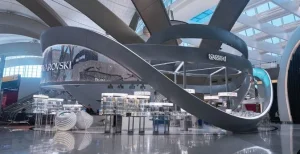
SSP is also trialling carbon labeling at its Ritazza and Camden Food Co. brands in Terminal A. Using the Klimato carbon labeling platform, the firm assessed the climate impact of its menu items, creating low-carbon specials and adding carbon labels and QR codes to menus to help educate customers about climate-smart choices. “A customer survey showed that 60% believed that carbon labeling helped them understand the environmental impact of the dishes,” Angela explains.
Sense of place
Within the retail and F&B spaces, local outlets help create a sense of place for passengers passing through Terminal A. Alongside this, the overall terminal has been designed to reflect the local culture and environment. “We had two guiding principles in the design: to create a building that serves the emirate and represents the city of Abu Dhabi, and to provide unrivaled customer experience and comfort through creating the most efficient building form. The undulating massing was inspired by the sand dunes in the immediate context of the terminal, as well as by the Emirati loose-fit dress costume that is designed to conceal and protect,” explains KPF’s Chehabeddine.
“The interior design, meanwhile, was adorned by the rich geometric patterns of Islamic culture as well as the different aspects that make up the environment of Abu Dhabi – sea, desert, city and oasis,” he adds.
Sorlini also notes that the airport’s rebranding as Zayed International Airport – in honor of the UAE’s founding father, the late Sheikh Zayed bin Sultan Al Nahyan – encapsulates the spirit of the facility beyond the steel and glass of its physical structure. “We were inspired by the design of this iconic terminal, with each pier representing and pointing to either the city, desert, oasis or sea.
“Using this for creative inspiration, we’ve linked each of those piers to a key landmark such as the historic walls of Qasr Al Hosn [the oldest stone building in Abu Dhabi], the legacy of Emirati navigators embodied by the dhow boat, and the enduring properties of date palm trees and the desert sun. These unique features create a sense of place for the passenger, who can benefit from an unforgettable experience.”
International profits
In March 2024, Travelex launched seven stores and eight ATMs in Terminal A of Zayed International Airport. The four landside and three airside stores take the total number of Travelex stores in the UAE to 49. This marks the latest milestone in Travelex’s expansion across the UAE and wider Middle East, increasing its extensive distribution network in the region.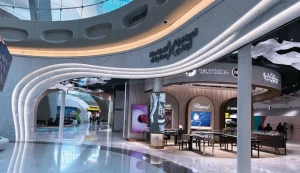
Batu Dolay, commercial director of Travelex Middle East and Turkey, said, “Zayed International Airport Terminal A sets a new benchmark for a modern, seamless airport experience, tying in perfectly with our mission to simplify our customers’ access to international money. We are therefore delighted to have launched seven new stores and eight ATMs across the new terminal, affording travelers flying to and from Abu Dhabi more convenience in their international money transactions than ever before.”
Etihad Airways’ premium lounges
Etihad Airways unveiled premium lounges at Zayed International’s new Terminal A in November 2023. The airline’s lounges span three floors of Terminal A’s north side, between Piers C and D. They provide access to three gates, so that guests in premium cabins on selected flights can board straight from the lounge. Within the lounge area, expansive views of the runway can be enjoyed from the calm and tranquil retreat in the East and West Study, which offers guests a place to watch aircraft take off or come in to land.
The First and Business lounges feature a range of dining options and relaxation and entertainment spaces, including the Constellation Bar in the enclosed Roof Lounge. The bar is decorated with a 172-piece, 25m-long bespoke glass lighting sculpture – named Panora – which depicts the Abu Dhabi city skyline. The bar serves a wide selection of cocktails, mocktails, wines and other beverages.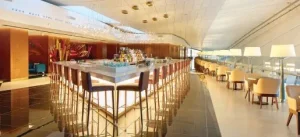
“When designing the Etihad Lounges in our new home, Terminal A, our teams thought through every detail, ensuring an experience that will delight our guests from the moment they step through the door,” said Antonoaldo Neves, CEO of Etihad. “The lounge is a hugely important aspect of our guests’ journey and we wanted to curate an impressive experience that will leave them wanting to fly again soon. In true Etihad style, we’ve been innovative with the design and will offer a selection of memorable experiences whether our guests choose to relax, indulge in various dining options or enjoy a refreshing drink at the signature Constellation Bar.”
This article originally appeared in the April 2024 issue of Passenger Terminal World. To view the magazine in full, click here.

